The 1967 dime is far from being the most valuable US coin. But it can still fetch you a decent amount if it’s in good condition. This article covers everything about the value of the 1967 Roosevelt dime, including error coins and special mint coins.
1967 Roosevelt Dime Value
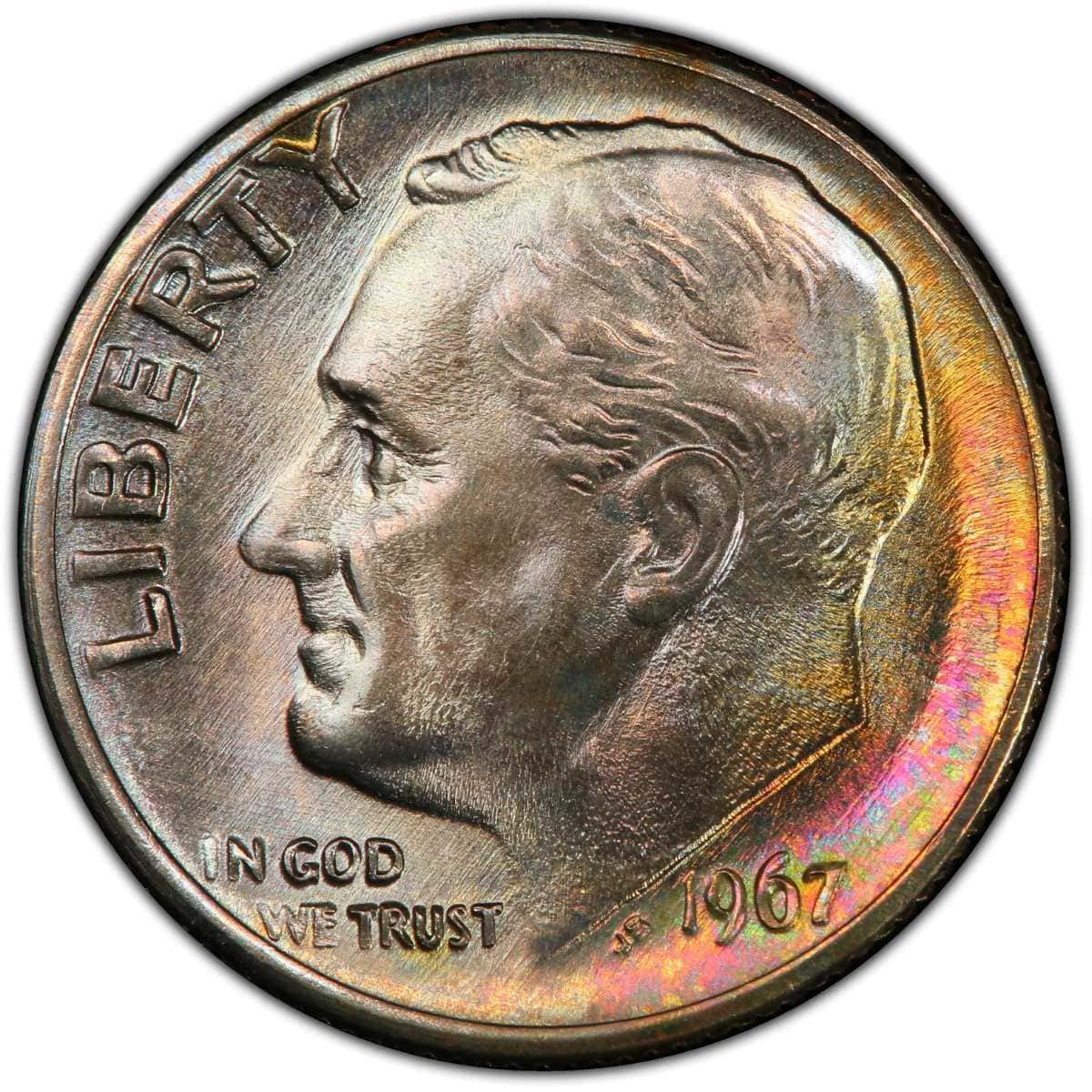
The 1967 dime, which belongs to the clad Roosevelt dime series introduced in 1965, features the design by John R. Sinnock, portraying US president Franklin Roosevelt on the obverse. The coin weighs 2.5g, consisting of 8.33% nickel and the remainder copper, has a reeded edge, and measures 25.2 mm in diameter.
The 1967 Roosevelt dime is a very common coin, with over 2 billion pieces minted across all types, making even the brilliant uncirculated dimes readily available and inexpensive.
| 1967 Dime Value Chart | |||
| Strike | Circulated | Uncirculated | Gem Uncirculated |
| (G4 – AU58) | (MS60 – MS64) | (MS65 – MS69) | |
| 1967 Dime | $0.15 – $2 | $4 – $7 | $8 – $475 |
| 1967 Dime, Full bands | – | $4 – $18 | $28 – $1,800 |
| 1967 Dime, Special Mint Set | – | $2 – $7 (SP) | $8 – $675 (SP) |
| $7- $18 (CAM) | $22 – $2,750 (CAM) | ||
| $125 -$150 (DCAM) | $225 – $13,750 (DCAM) | ||
The overabundance of these dimes means that the circulated coins cost little more than the face value, with prices ranging from $0.15 to $2.
On the other hand, uncirculated coins which are also common cost between $4 to $8. Only gem uncirculated dimes graded above MS66 are scarce, so can fetch up to $475.
But the most valuable 1967 business strike dimes are the uncirculated coins with full bands which start small, but the highest grades can be worth as much as $1800.
1967 Dime Normal Coins Value
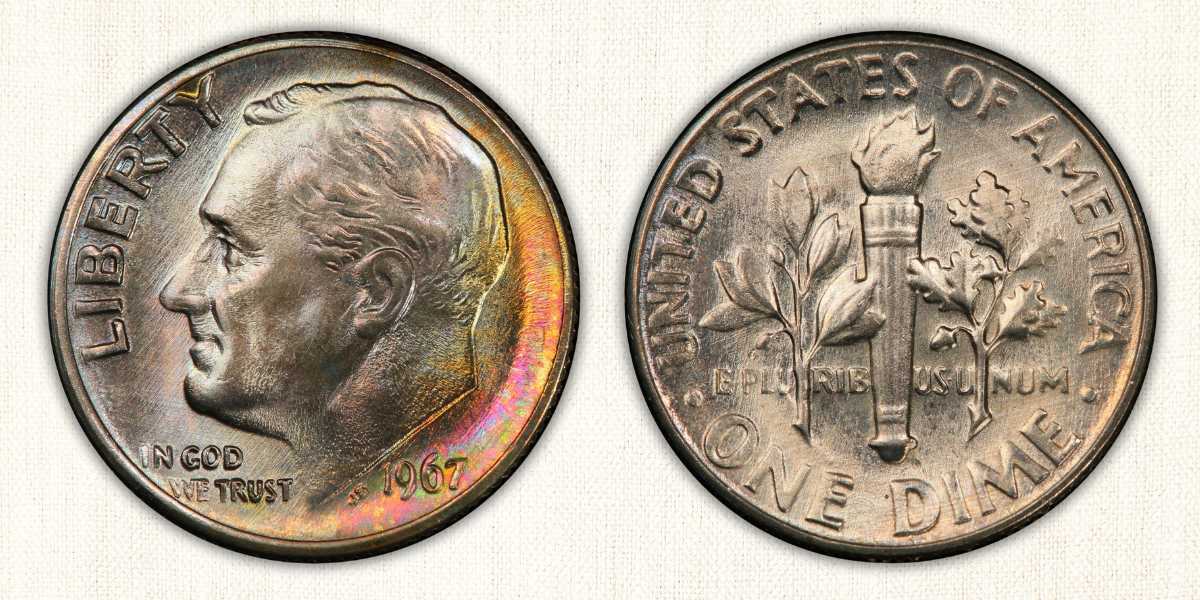
Although the 1967 Roosevelt dimes were produced across various mints including Philadelphia, Denver, and San Francisco, they did not bear a mint mark as per the provisions of the Coinage Act of 1965, which temporarily suspended the use of mint marks. Due to the sheer volume of the coins minted and how recently they were struck, the coin has a very low numismatic rarity.
And since value is directly influenced by rarity, the dimes aren’t particularly valuable. Low-grade circulated 1967 dimes have little or no numismatic value as they are worth slightly more than the coin’s face value of $0.10.
Almost uncirculated dimes are worth $2 and entry-level uncirculated dimes cost $4. Even at gem uncirculated grades, the 1967 dimes are still common, so the price is still affordable at $10 for MS65 and $42 for MS67.
But as the coins become scarce at MS68, there’s a spike in the price. You could get about $400 for an MS68 1967 dime.
| 1967 No-mint Mark Dime: Value Chart | |
| Grade | Value |
| Good (G4) | $0.15 |
| About Uncirculated (AU58) | $2 |
| MS 60 | $4 |
| MS 61 | $4 |
| MS 62 | $4 |
| MS 63 | $5 |
| MS 64 | $7 |
| MS 65 | $8 |
| MS 65+ | $10 |
| MS66 | $15 |
| MS 66+ | $20 |
| MS 67 | $32 |
| MS 67+ | $42 |
| MS 68 | $400 |
1967 Full Bands Dime Value

Another factor that influences the value of a 1967 dime is full bands. Full bands are the twin horizontal bands on the torch on the reverse of the coin.
1967 dimes (and all other Roosevelt dimes) with full bands are regarded as well-struck with all the details crisp and clear, and as such, these coins command a higher premium than regular uncirculated dimes. However, in the case of the 1967 dime, the price difference isn’t too great. An MS60 costs $4, while MS65 costs $28.
Moving on to the higher grades, the price difference becomes more appreciable. A full band MS66 1967 dime is worth $100, and an MS68 is worth $1,800. These prices are about five times as much as normal MS dimes.
As you’d expect, full bands also do better at auctions than the normal MS dimes. The record stands at $1,440 for a full band MS68 1967 dime, auctioned in 2020 by Heritage Auctions.
| 1967 Full bands Dime Value Chart | |
| Grade | Value |
| MS 60 | $4 |
| MS 61 | $5 |
| MS 62 | $7 |
| MS 63 | $10 |
| MS 64 | $15 |
| MS 64+ | $18 |
| MS 65 | $28 |
| MS 65+ | $46 |
| MS66 | $100 |
| MS 66+ | $150 |
| MS 67 | $250 |
| MS 67+ | $475 |
| MS 68 | $1800 |
1967 SMS Dime Value
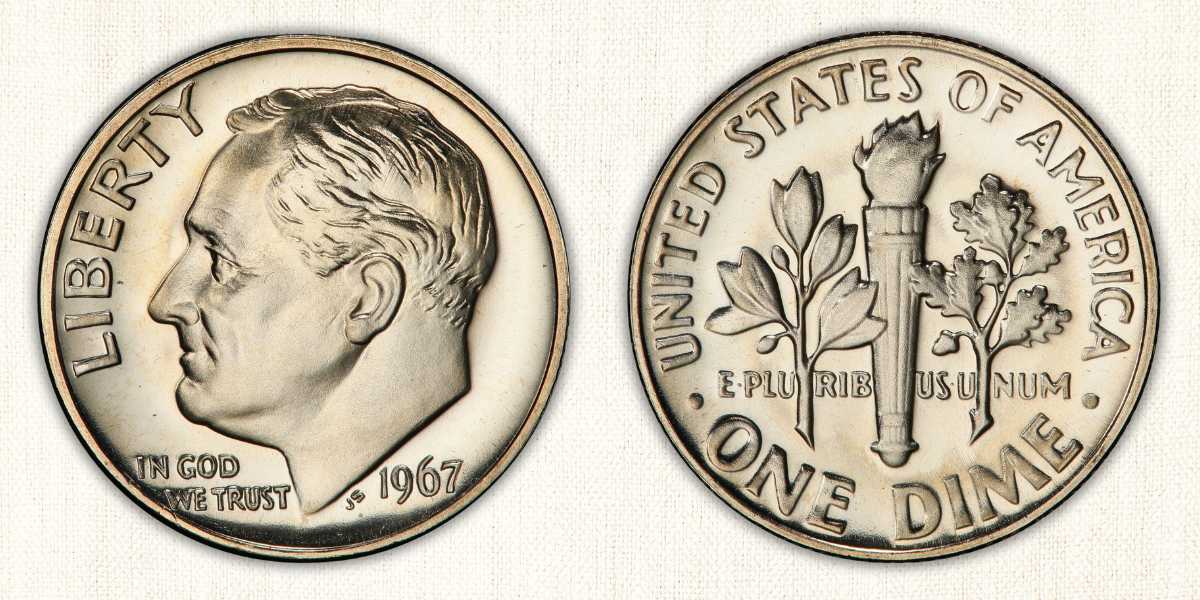
Besides the business strike coins, the mint also produced 1.8 million special mint set coins (SMS) of the 1967 Roosevelt dime. SMS coins are almost as good as proof coins, and they have the same grading designations (SP, CAM, DCAM).
The specimen (SP) dimes, which are the lowest designation are also the most abundant 1967 SMS dimes. The prices for these are similar to the uncirculated business strike dimes. It costs $2 for an MS60 and $85 for an MS68.
Cameo (CAM) SMS dimes which have a mirror-like field (or background) are the next in appeal and value. 1967 Roosevelt CAMs are not very scarce, you can get them for $7 to $75 for grades below MS68. But MS69 Cameos which are rare cost $2,750.
The rarest 1967 SMS dimes are the Deep Cameos which have a deeper mirror-like field compared to the cameos. It costs $225 for an MS65 DCAM, $1,750 for an MS67, and $8,750 for a near-perfect MS68+.
But some DCAM 1967 dimes can cost even more. The record stands at $9,987 for an MS68 DCAM sold at a 2014 Heritage Auctions auction. Additionally, PCGS has graded just one MS69 DCAM 1967 dime, and the coin is valued at an impressive $13,750.
| 1967 SMS Dime Value Chart | |||
| Grade | SP | CAM | DCAM |
| MS60 | $2 | $7 | – |
| MS61 | $3 | $8 | – |
| MS62 | $4 | $9 | – |
| MS63 | $5 | $13 | – |
| MS64 | $6 | $17 | $125 |
| MS64+ | $7 | $18 | $150 |
| MS65 | $8 | $22 | $225 |
| MS65+ | $8 | $24 | $235 |
| MS66 | $10 | $30 | $285 |
| MS66+ | $11 | $32 | $425 |
| MS67 | $14 | $35 | $925 |
| MS67+ | $16 | $75 | $1,700 |
| MS68 | $26 | $165 | $6,000 |
| MS68+ | $85 | $360 | $8,750 |
| MS69 | $675 | $2,750 | $13,750 |
1967 Roosevelt Dime: Error Coins
Due to its large mintage, there are more 1967 error dimes than years with smaller mintages like the 1968 and 1969 dimes.
The errors are not only limited to the business strike dimes, as there are also error SMS dimes.
1967 error dimes generally have a significantly higher value than the non-error coins. Some of the common errors include strike errors, clad errors, and clipped planchet errors.
1967 Roosevelt Dime Reverse Die Crack Error Coin
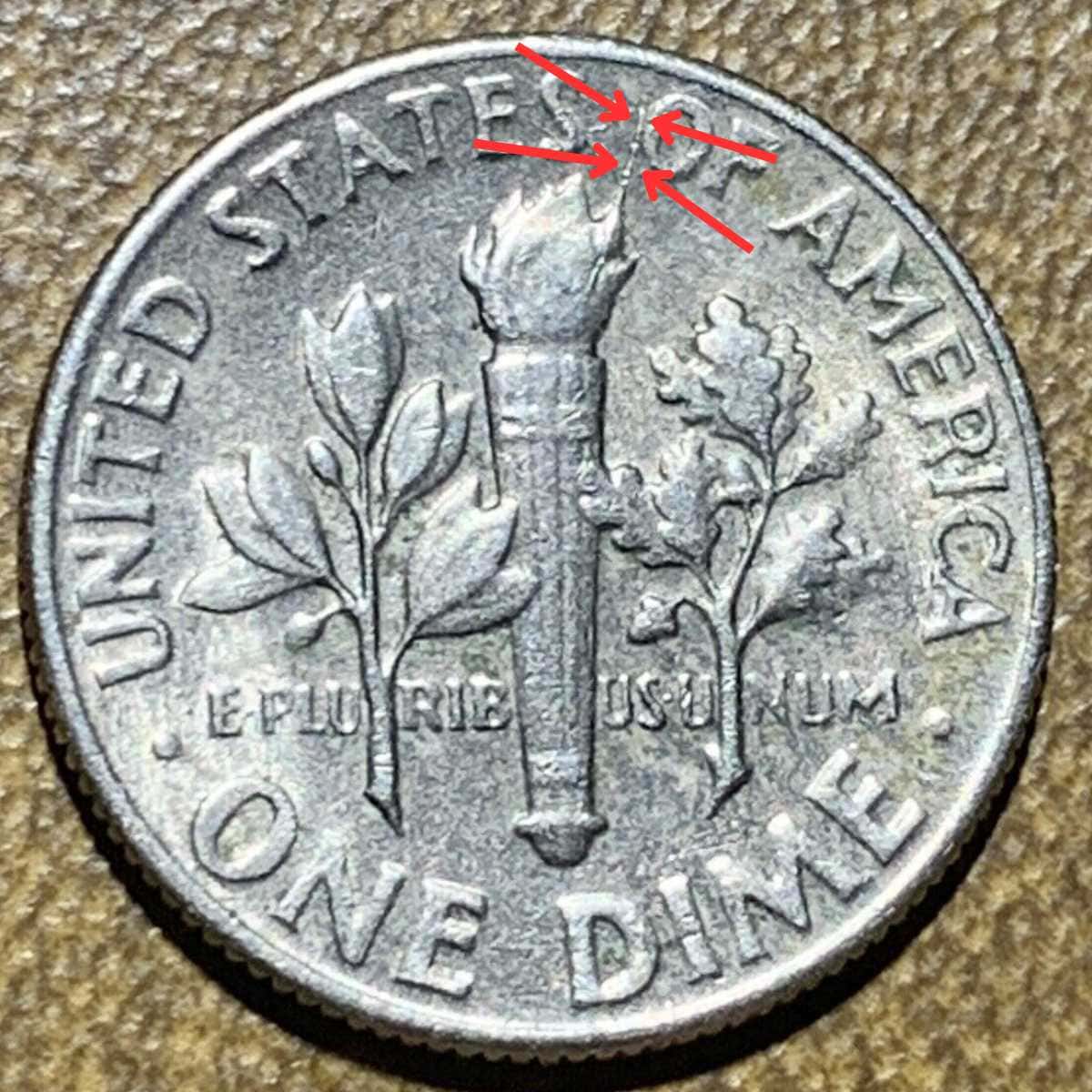
This 1967 Roosevelt dime has a die crack error on the reverse.
This type of error occurs when a die with a crack is used to strike a coin. When this happens the metal will fill into the crack, producing a coin with a raised line in the shape, and length of the crack.
For this coin, the crack is on the reverse. It’s a small line extending from one of the flames on the torch to the edge of the coin. The coin is almost uncirculated and is valued at $20.
1967 Roosevelt Dime Obverse Struck Through Error Coin
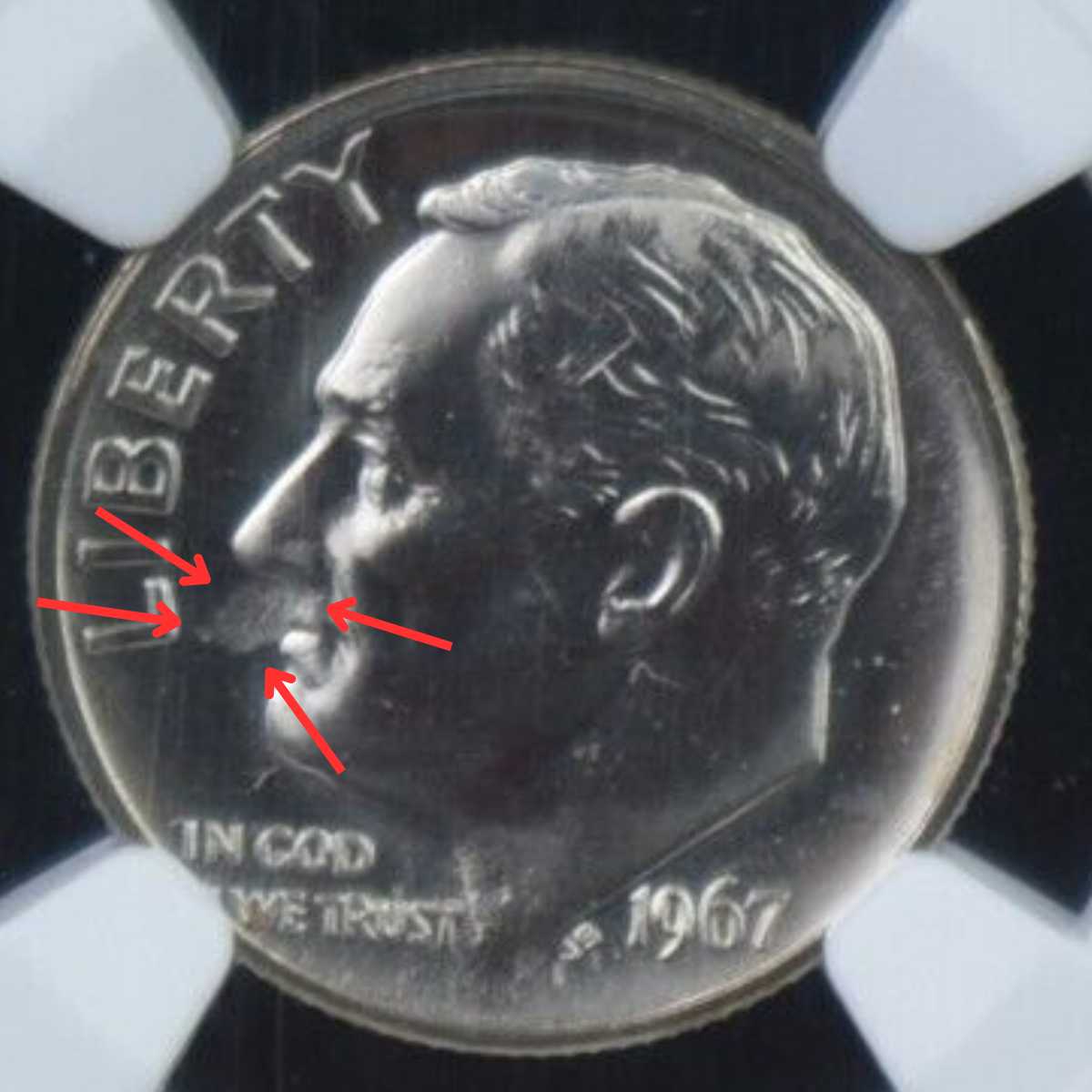
Struck through errors happen when there’s an object between the die and the planchet. Depending on the object, it may leave a mark on the coin, or simply make the details faint.
This coin was struck through on the obverse, you can see the error close to Roosevelt’s nose and mouth, it appears rough rather than smooth and reflective like the other parts of the coin.
Despite the error, the coin is still an impressive SMS MS67 dime and costs $84.
1967 Roosevelt Dime Clipped Planchet Error
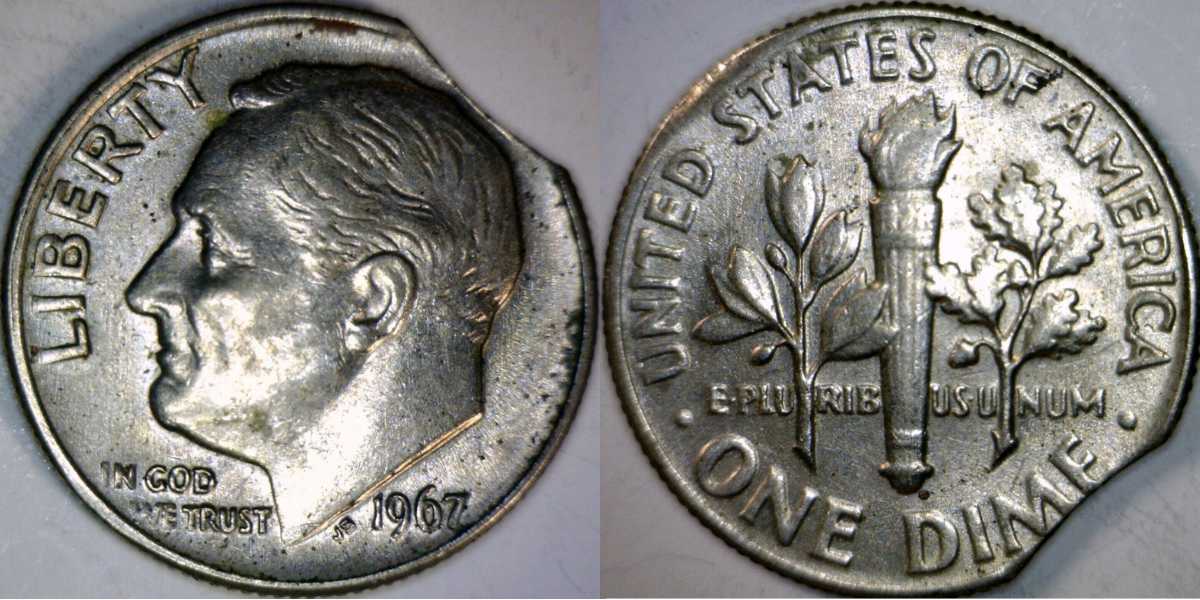
Here is a $10 circulated 1967 Roosevelt dime with a clipped planchet. The clip is slightly concave and happened because the punch on the blanking press slightly overlapped a previously punched hole.
The error is a small one, located right behind the President’s head. On the reverse, it’s located right under the word “DIME” where it cuts a small section of the last letter.
1967 Roosevelt Dime Missing Clad Layer Error

Errors such as this happen when the clad layer isn’t well bonded to the copper core. Or when the clad layer doesn’t extend completely over the planchet. As such the copper core will get struck and bear the coin design.
Due to the missing layer, the coin will be about 15% lighter, and will, of course, have a different color on the affected face. This almost uncirculated 1967 dime is missing a clad layer on the obverse. This coin is NGC certified as AU55, and costs $61
1967 Roosevelt Dime Broad Strike Error
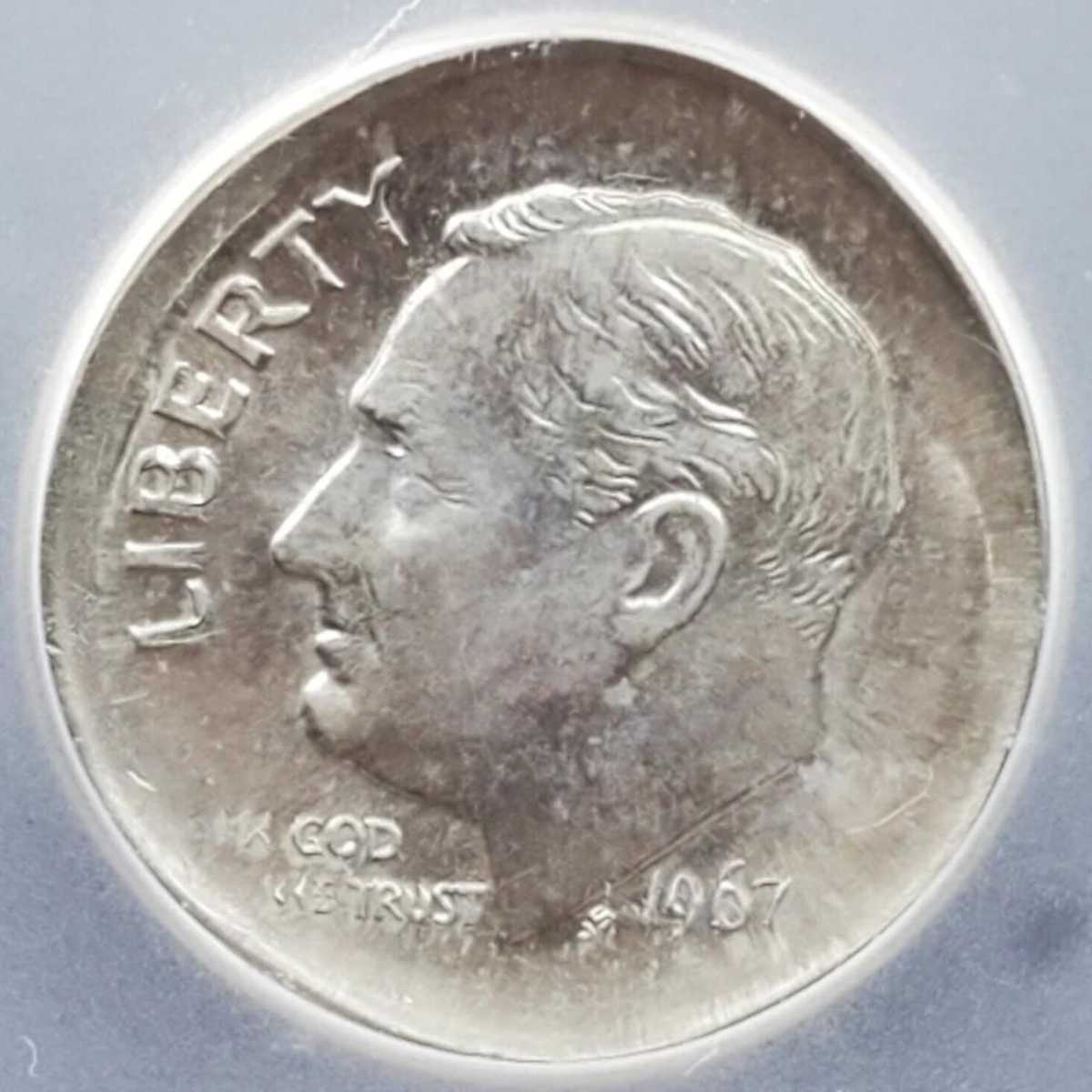
This 1967 dime with a broad strike error is valued at $60. Broad strikes are caused by a failure with the restraining collar that keeps the planchet in place during the strike and also forms the edge.
Since the collar isn’t present, the coin becomes flattened and expands due to the force of the strike. Broad strikes can be off-center, or on-center like this coin. However, because of the expansion, there is a small blank space around the coin face. Besides that, all the other details of the coin are correct.
1967 Roosevelt Dime Weak Strike, Die Adjustment Error
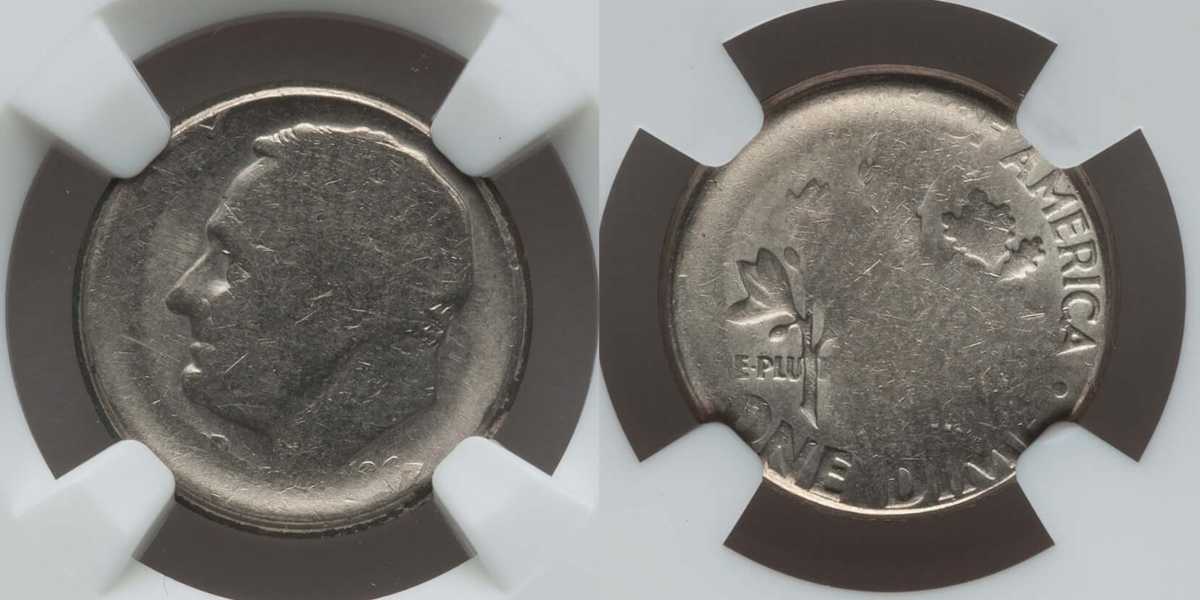
Much of the details on this circulated 1967 Roosevelt dime appear faint, and some don’t even show at all. This weak strike was caused by a die adjustment strike.
Die adjustment errors are instances when the striking dies have been placed too far apart from the planchet that when pressure is applied, the dies only make partial contact with the planchet leaving a weak strike. Weak strikes can also be caused by insufficient striking pressure.
It’s almost impossible to determine the exact cause of a weak strike. But regardless of the cause, affected coins will always be fainter at the edges than the center. That’s the case with this coin, where only Roosevelt’s face in the center is clearly visible, the date at the bottom is very faint, and the “LIBERTY” motto doesn’t appear at all. The coin is worth about $100.
1967 Roosevelt Dime Double Denomination Error

The coin was originally a 1967 dime but was later struck again by a penny die, giving it two different denominations. You can see both denominations on the coin, but the penny was struck 20% off center, cutting off the date.
Double denomination errors are very rare and valuable. This coin is valued at $5,180.
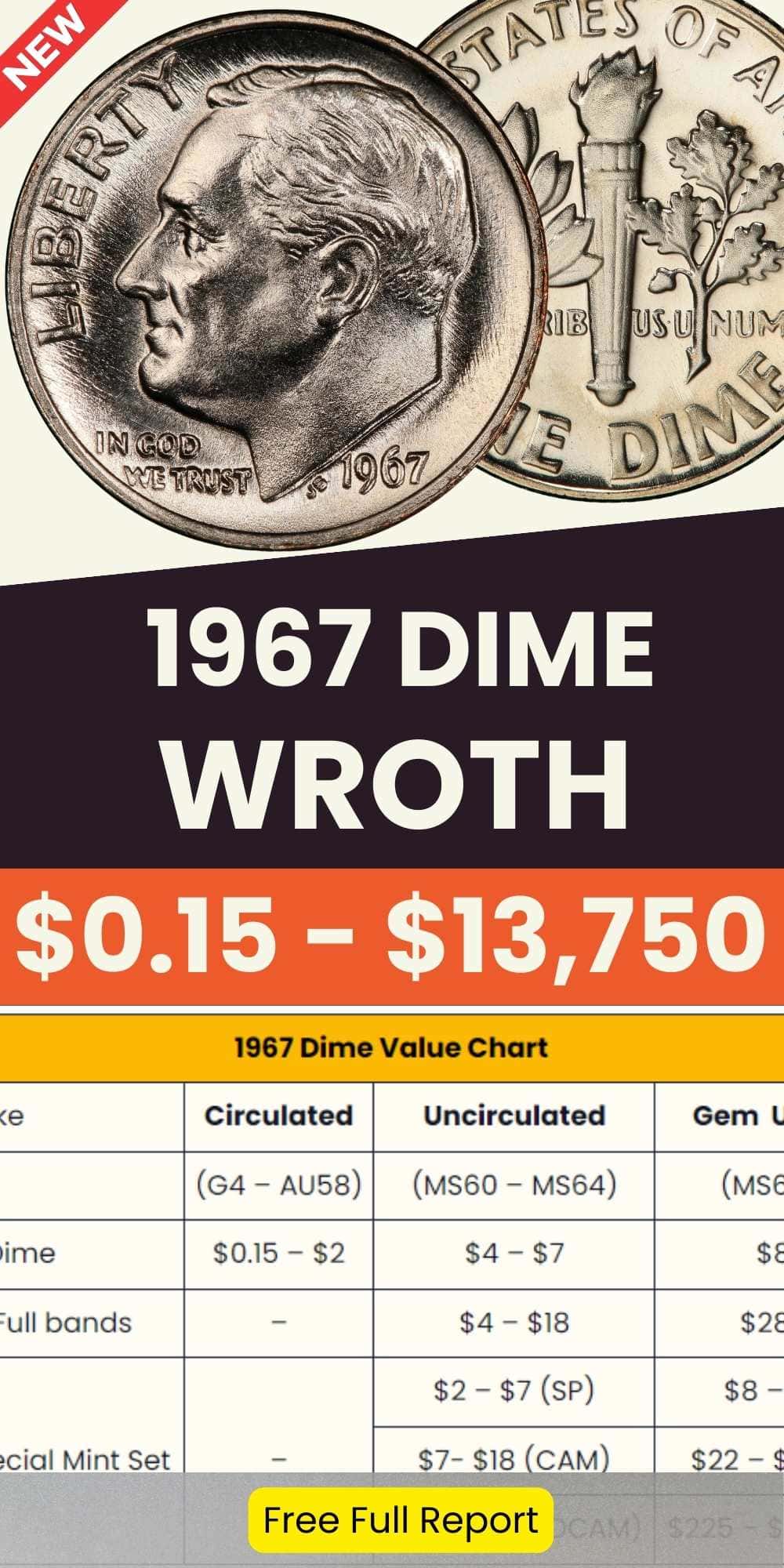

Jenson is a professional numismatist, a dedicated coin collector, a graduate of the College of Business at Oregon State, a life member of the American Numismatic Association (ANA), and an overall coin nerd. He is the founder of Coin Value List.
